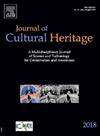Effects of combined increase in temperature and CO2 concentration on the weathering activity of phototrophic organisms inhabiting granitic rocks and its implications in terms of cultural heritage conservation
IF 3.5
2区 综合性期刊
0 ARCHAEOLOGY
引用次数: 0
Abstract
The increase in CO2 concentration and temperature observed in the current context of climate change may cause changes in the behavior of phototrophic organisms colonising stone cultural heritage, leading to undesirable changes in terms of biodeterioration. In this study, we examined the combined effect of both parameters (18°C or 24°C and ambient or high CO2 concentration) on the physiological state of organisms and on granite weathering through experiments involving a green alga (Bracteacococcus minor) and a cyanobacterium (Synechocystis sp. PCC 6803) grown in medium containing granite. The results revealed an increase in the green algae population relative to the cyanobacteria at lower temperature and a reduction in biomass and efficiency during the early stages of culture development at the higher temperature. In addition, although rock weathering was favoured by modification of the solution equilibrium through cation uptake by the organisms no significant differences in response to environmental conditions were detected.

温度和CO2浓度联合升高对花岗岩光养生物风化活动的影响及其文化遗产保护意义
在当前气候变化的背景下,二氧化碳浓度和温度的增加可能会导致光养生物在石头文化遗产上的行为发生变化,从而导致生物退化方面的不良变化。在这项研究中,我们通过在含有花岗岩的培养基中生长的绿藻(小Bracteacococcus minor)和蓝藻(Synechocystis sp. PCC 6803)实验,研究了这两个参数(18°C或24°C以及环境或高浓度二氧化碳)对生物体生理状态和花岗岩风化的综合影响。结果表明,在较低温度下,绿藻数量相对于蓝藻增加,而在较高温度下,培养发展的早期阶段,生物量和效率降低。此外,尽管生物通过阳离子吸收改变溶液平衡有利于岩石风化,但对环境条件的响应没有显著差异。
本文章由计算机程序翻译,如有差异,请以英文原文为准。
求助全文
约1分钟内获得全文
求助全文
来源期刊

Journal of Cultural Heritage
综合性期刊-材料科学:综合
CiteScore
6.80
自引率
9.70%
发文量
166
审稿时长
52 days
期刊介绍:
The Journal of Cultural Heritage publishes original papers which comprise previously unpublished data and present innovative methods concerning all aspects of science and technology of cultural heritage as well as interpretation and theoretical issues related to preservation.
 求助内容:
求助内容: 应助结果提醒方式:
应助结果提醒方式:


